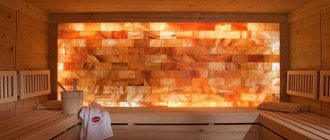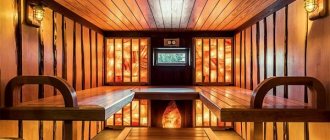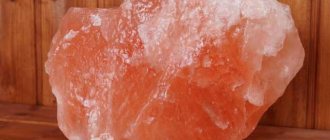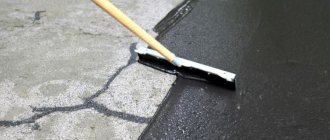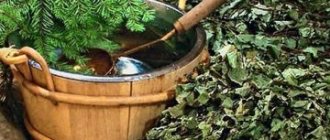The bathhouse is a favorite place to relax, where you can not only spend your leisure time, take a steam bath, but also improve your body’s health. It is not without reason that only natural materials are used for its finishing. Tiles made of Himalayan salt are often used as facing products for steam rooms. This rock, when heated, is able to disinfect the environment and have a beneficial effect on many important systems of human life. Himalayan bath salt can be used as a coating for walls, ceilings and floor surfaces.
Himalayan bath salt
What's good about salt?
The largest salt deposits are found in Pakistan. The rock was formed from a mixture of ocean salt and molten magma. It is mined by hand.
Extraction of Himalayan salt
The healing powers of crystals were known to Tibetan monks, who added it to their food and tea. The crystals have a salty-sweet taste, different from ordinary table salt, and a soft, pleasant aroma. If you use such a product for cooking instead of the usual salt, the food will become healthier and tastier, and will also acquire a refined aroma.
Himalayan salt is also distinguished by its 100% digestibility by the body and its lower content of sodium chloride, which is found in large quantities in table salt, which is why it is considered very harmful.
Beneficial properties of Himalayan salt
Important! It is worth noting that today a large amount of fake salt is offered, made from a rock or sea analogue, painted pink. Such crystals not only will not bring any benefit, but can cause harm when exposed to high temperatures (due to evaporation of the dye).
Himalayan salt.
How to distinguish a fake? The beneficial properties of the mineral are determined by its composition. The crystals contain more than 80 trace elements and other components that are preserved during rock mining and processing, including: K, Ca, Cu, Mg and Fe, and are free of harmful impurities. Depending on how much manganese and iron there is in the salt, the shade of the crystals also changes. They can be pale, bright pink, red, orange and even black. Pink salt is more common.
Salt crystals are very useful
The interesting texture of the rock could not go unnoticed. But the most popular area of application has become cladding in baths and saunas, in which, when heated, salt vapors have a healing effect on humans.
What's in Pink Himalayan Salt?
Salt is useful for:
- metabolic disorders;
- respiratory diseases;
- hypertension;
- problems in the genitourinary system;
- sleep disturbance;
- neuralgia;
- joint diseases;
- diseases of the cardiovascular system;
- skin problems;
- weakened immunity;
- asthma;
- digestive problems;
- cold.
Iodine contained in large quantities has a positive effect on the thyroid gland. In addition, salt helps the body cleanse itself of waste products, stimulates brain activity, and also promotes the healing of skin inflammations and wounds.
The most popular use for salt has become lining in baths and saunas.
Important! Himalayan salt can be harmful to those who suffer from kidney failure, oncology, diabetes, epilepsy, acute glaucoma and blood diseases. Individual intolerance is also a contraindication. Women during menstruation and pregnant women should also refrain from inhaling fumes.
Prices for Himalayan bath salt
Himalayan bath salt
What to do if you want something salty
Best materials of the month
- Coronaviruses: SARS-CoV-2 (COVID-19)
- Antibiotics for the prevention and treatment of COVID-19: how effective are they?
- The most common "office" diseases
- Does vodka kill coronavirus?
- How to stay alive on our roads?
According to the study Calcium and Salt Intake (Monell Chemical Senses Center, Philadelphia, PA, United States), the desire to eat salty foods is triggered by a deficiency of minerals in the body. The lack of vital nutrients affects not only your health, but also your eating habits.
How do nutritionists explain this? Salt contains more than 60 minerals. The body senses a lack of a certain nutrient and finds the easiest way to make up for the deficiency.
Salt cravings can also be triggered by dehydration. Salt helps cells retain internal moisture and provides additional nutrition. The body resorts to the most reasonable method - to accumulate as much fluid as possible in order to protect itself from possible deficiency.
How to suppress the desire for salty foods:
- adjust your diet to get the required list of nutrients;
- include fresh vegetables, fruits, legumes in the menu;
- use seaweed as an alternative to salty industrial products;
- replace regular table salt with pink Himalayan salt;
- Drink the required amount of water based on height, weight, age and needs.
The use of crystals in the bath
Himalayan salt is often used in the production or assembly of lamps, panels, bowls and lampshades, as well as as a base for making soap. Small pebbles can become decorations for interior items. Pebbles can also be placed on hot stove stones.
Himalayan salt is widely used in saunas and baths
Lampshades
In addition to the ability to decorate the interior, lampshades can also perform practical functions. A lamp that heats up during operation can become a source of healing fumes if you place salt stones or tiles next to it.
What is required from a lampshade:
- inertness to moisture;
- resistance to temperature influences;
- structural strength.
Typically, such interior items are located in the corners of the steam room or relaxation room.
Himalayan salt lampshade
What materials can the lampshade be made from:
- wood, which is environmentally friendly and harmonizes perfectly with the overall finish;
- metal;
- high temperature resistant plastic;
- glass;
- Himalayan salt itself. The last option is distinguished by the greatest originality and aesthetics.
Lampshades with Himalayan salt
Bowl with stones
The easiest way to create a pleasant microclimate in a room is to place Himalayan salt in a decorative bowl and hang or fasten it near a heat source.
Bowl with Himalayan salt
Lamps
The lighting device, made of salt stone and a lamp placed inside, looks very interesting. Moreover, the mineral itself can be whole or processed to give it a certain shape. There are several installation options: hanging from the ceiling, mounting on a wall or installing on a horizontal surface.
Himalayan salt lamp
Panel
Such decorative elements greatly decorate the room. Panels can be laid out from salt products of various shapes. They are hung on the wall or built into it at the finishing stage. We must admit that this designer item is not cheap at all. But placing a small salt object in the steam room is still cheaper than covering an entire wall.
Salt panel in the steam room
To improve the aesthetics of the structure, it is recommended to use LED lighting. The shapes and dimensions of the panels can be different. You can make them yourself or purchase ready-made products.
Soap
In the bathhouse (and not only there) you can use soap made from salt. It is able to disinfect and cleanse the skin, as well as nourish it. With its help you can fight acne and cellulite, improve blood circulation and improve skin tone. Soap acts as a scrub. Despite the fact that salt dissolves in an aqueous environment, one piece lasts for a long time.
Eco-friendly Himalayan salt soap
However, the main purpose of Himalayan salt is to coat surfaces in the bathhouse.
Himalayan salt brick prices
Himalayan salt brick
Himalayan salt as a finishing material
The material is durable, despite the fact that the translucent rock gives the impression of fragility. Blocks and tiles made from rock can withstand significant loads. The products can withstand high temperatures (up to +550 degrees) without destroying the structure.
Himalayan salt as a finishing material
Important! However, you need to understand that a humid environment can have a destructive effect on the crystals, so splashing water on the finish should be avoided.
Other finishing materials often cannot compete with natural relief and unique patterns.
Finishing salt is available in the form:
- blocks 10 cm thick;
- bricks 5 cm thick;
- tiles 2.5 cm thick.
Forms of salt release
Tiles and bricks are used not only for complete wall cladding, but also for creating beautiful compositions. The floor in the steam room is usually laid with salt bricks or blocks. You can walk on it without shoes; the salt has antiseptic properties. And the untreated surface also has an acupuncture effect.
The salt wall, illuminated with LED strip, looks very beautiful.
Backlit Himalayan salt wall
Conditions under which Himalayan salt will retain its operational and medicinal properties for a long period:
- the humidity level in the steam room should not exceed 50% (at a time when the steam room is not in use, short-term exposure to water is acceptable);
- Any water that gets on the salt must be wiped off;
- A ventilation system or constant ventilation of the room is required.
There is no need to worry about exposure to high temperatures. Salt can withstand temperatures exceeding 500 degrees. On the contrary, higher temperature conditions increase the intensity of evaporation.
To install slabs, blocks and bricks made of Himalayan salt, special adhesives or a frame system of metal profiles are used. In the latter case, hidden or visible fastening options are used.
Using a system of metal profiles
You can make the glue yourself: you will need to mix magnesium chloride and magnesite in a ratio of 5:3. However, it is easier and more reliable to use ready-made compounds. Many people use liquid glass for installation, but such fastening is not reliable.
Features of use and industrial production
The pink mineral is used not only in the gastronomic industry, but also in medicine, cosmetology, and decoration. It is used to decorate dishes, natural interiors, enrich cosmetics and add to medicines for the nasopharynx. Pink crystals are also used for salt baths.
Serving utensils and food preparation devices are created from massive crystalline slabs. Pink slabs are also used for storing fresh/frozen meat and fish. Animal bran is placed on a stove, left for several hours or a day, after which it is slowly heated to a temperature of 200°C. A heated piece of mineral serves as a real cooking surface. There is a uniform temperature distribution, so the finished dishes are completely safe and suitable for consumption.
The best adhesives for laying salt
If you decide to fix salt with glue, then you need to approach the choice of composition responsibly. The glue must have several important qualities:
- be environmentally friendly, safe for health;
- the composition should not damage the decorative effect of the finishing material;
- the material must withstand temperature influences and a humid environment;
- have good adhesion to substrates;
- have a service life no less than that of salt.
TOP 5 best adhesives for Himalayan salt
| Photo | Name | Rating | Price | |
| #1 | Fire stone | ⭐ 4.95 / 5 2 - votes | Find out the price | |
| #2 | EOS Salzkleber | ⭐ 4.9 / 5 | Find out the price | |
| #3 | SlRus | ⭐ 4.85 / 5 | Find out the price | |
| #4 | Leader | ⭐ 4.8 / 5 1 - voice | Find out the price | |
| #5 | Neptune Hermes | ⭐ 4.75 / 5 | Find out the price |
Which Himalayan salt glue would you choose or recommend?
Take the survey
No. 5. Neptune Hermes
The adhesive, consisting of one component, is intended for gluing together and gluing products made from Himalayan salt to any base. It is made from natural ingredients, biologically neutral, and can withstand temperature changes. Material consumption per 1 sq. m. - 2 kg.
Neptune Hermes
pros
- environmental Safety;
- ready to use;
- affordable price.
Minuses
- high consumption.
No. 4. Leader
Using a two-part solution, you can bond Himalayan salt trim in a short time. Before starting work, it is necessary to mix the components until homogeneous: the first is pink salt in powder form, the second is liquid magnesium binder. The composition sets very quickly: within a quarter of an hour the tile will be securely fixed. For cladding 1 sq. m of base requires 1 kg of glue.
Leader
pros
- moisture resistance;
- reasonable price;
- fast setting;
- reliability of fixation;
- easy application.
Minuses
- mixing of components is necessary;
- Due to rapid hardening, the mixture must be used within a short period of time.
Prices for two-component salt glue
Two-component salt glue
No. 3. SlRus
The adhesive composition can be made independently from two components (magnesium binder and sealer) mixed with water. The contents of the packages are mixed according to the instructions (60% component 1 and 40% component 2), and then dissolved in water until a homogeneous paste is obtained. It is applied in a thin layer to the salt product, after which the lining is fixed to the base. The finished mixture should be used within 10 minutes. The glue completely crystallizes in 3 hours. Since the composition in its solid state has a gray tint, you need to apply it carefully, trying not to stain the outside of the tile. A mixture of 1 kg of glue and 0.25 liters of water is enough to process 5 square meters. m. surface.
SlRus
pros
- strong salt fastening;
- economical consumption;
- fast setting time.
Minuses
- low viability of the mixture.
No. 2. EOS Salzkleber
One-component composition of German production, packaged in 1 kg, ready for use. To do this, you just need to dilute it with water and mix thoroughly. The mass should be homogeneous. After this, the material is applied to the surface of the salt product and it is installed in place.
EOS Salzkleber
The prepared paste should be used within ten minutes. The glue meets all European quality standards and is harmless to others. It can be used in places where the temperature reaches 110 degrees.
pros
- environmental friendliness;
- ease of use;
- fast crystallization.
Minuses
- high price;
- low viability of the mixture.
No. 1. Fire stone
The one-component mineral-based adhesive is supplied ready-to-use (it only needs to be mixed thoroughly before use). The red paste is specially designed for mounting Himalayan salt.
Fire stone
Distinctive features of the material: inertness to water and high temperatures (withstands exposure to up to 1400 degrees), as well as environmental safety (does not emit harmful substances and is odorless). Composition density: 1.8-1.9 g/cc. Complete hardening occurs within 1-3 days (depending on the applied thickness). The glue must not be diluted with water or solvent. Minimum paste consumption: 200 g/m2. m. A notched trowel is used for application.
The glue can be stored in unheated areas. The frozen composition must be warmed to a temperature of +5 degrees before use. The performance characteristics will not change. The manufacturer allows an unlimited number of freeze/thaw cycles.
pros
- ease of use;
- environmental Safety;
- affordable price;
- heat resistance.
Minuses
- long-term crystallization.
Prices for glue for Himalayan salt
Himalayan salt glue
Table. Comparison of glue from different manufacturers.
| Glue brand | Packaging, kg | Type | Cost, rub. |
| Fire stone | 1,5 | One-component | 420 |
| SlRus | 1 | Two-component | 1200 |
| Salzkleber Salt glue | 1 | One-component | 1600 |
| Neptune Hermes | 1 | One-component | 500 |
| Leader | 3 | Two-component | 1400 |
Himalayan salt
Finishing bath walls with salt
The walls on which the salt is mounted are finished with mineralite sheets (fiber cement boards). To carry out the work you will need: salt, primer, adhesive composition, mixer and tools for applying primer and glue.
Preparing everything you need
It is recommended to use compositions specially designed for the installation of Himalayan salt, and not to prepare them yourself.
It is better to use special glue
What's good about this glue: it's inexpensive and consists of one component, so it doesn't take time to prepare the mixture. It is enough to simply mix the composition in a jar with a mixer or a drill with an attachment to obtain a homogeneous consistency. The salt is placed on this glue.
Preparation of glue
Important! You can use a two-component material, but in this case the area to be finished should be located at a distance from the stove (at least 30...50 cm must be removed).
If there is a need to salt a wall in the immediate vicinity of the stove, it is important to leave a gap of 3-4 mm between the elements (it is best to use plastic crosses for this, which will ensure evenness of the seams). These precautions have a simple explanation: when exposed to high temperatures and a humid environment, salt tiles may fall off. Before starting work, the room where the salt is installed must be ventilated.
Primer type "Betonokontakt"
Prices for Betonokontakt
Concrete contact
Step 1 . The mineralite wall is treated with a primer. It is best to use Betonokontakt for these purposes. Otherwise, the adhesion of the materials will be weak and the salt may fall off. The base must dry.
Step 2 . The salt tile is cleaned and degreased.
Step 3 . An adhesive composition is applied to the salt tile. Its thickness must be at least 10 mm.
Glue is applied to the tiles
You should try to press the glue into the base of the salt product. Using a notched trowel, the solution acquires relief.
Using a notched spatula
Step 4 . Salt sticks to the wall of the bathhouse. The tile is fixed so that each row is offset relative to the previous one. The work should be carried out carefully; it is important to ensure that the composition does not get on the tiles, otherwise its appearance will be ruined.
Laying Himalayan salt tiles
After finishing, the glue should completely harden. For 24 hours after installation, drafts and low temperatures in the room should not be allowed.
It is also recommended to install lamps made of Himalayan salt in the bathhouse. And wall lighting will create a special relaxing atmosphere.
It’s nice to be in such a room and improve your health
Broken tiles can be laid directly on the heater.
Prices for Himalayan salt tiles
Himalayan salt tiles
Video - Himalayan salt in my bath
Contraindications
There are no special contraindications to using salt in a bath.
The only direct prohibition is the use of salt compounds on open wounds, cuts, and burns.
This can lead to unnecessary skin irritation and increased healing time.
You should not abuse salt vapors in the bath in the following cases:
- angina. With this disease, a bath is not recommended at all, as swelling of the throat may occur;
- oncological diseases;
- epilepsy;
- hypertension;
- open wounds, etc.
When in the bathhouse, you should be attentive to your condition and monitor your well-being. In addition to the high temperature, salt vapor creates additional stress on the body, so you should not stay under the influence for a long time.

